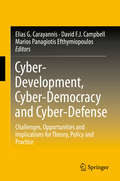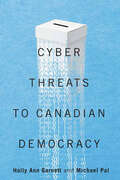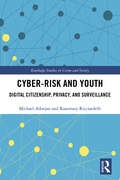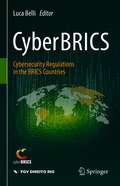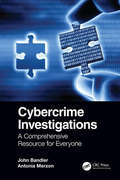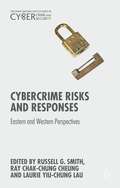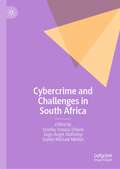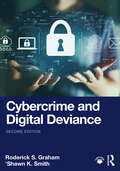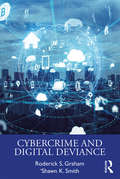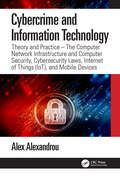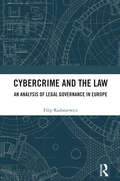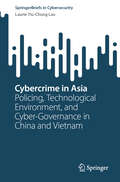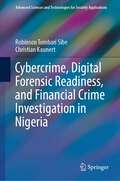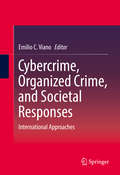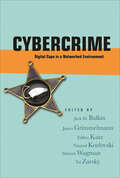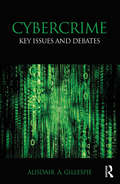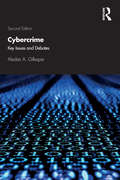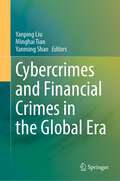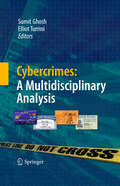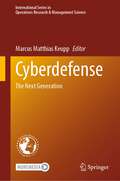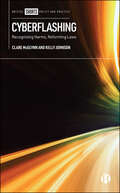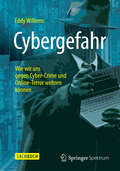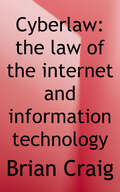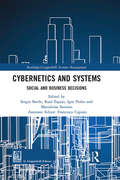- Table View
- List View
Cyber-Development, Cyber-Democracy and Cyber-Defense: Challenges, Opportunities and Implications for Theory, Policy and Practice
by Elias G. Carayannis David F. J. Campbell Marios Panagiotis EfthymiopoulosIn this volume, contributors from academia, industry, and policy explore the inter-connections among economic development, socio-political democracy and defense and security in the context of a profound transformation, spurred by globalization and supported by the rapid development of information and communication technologies (ICT). This powerful combination of forces is changing the way we live and redefining the way companies conduct business and national governments pursue strategies of innovation, economic growth and diplomacy. Integrating theoretical frameworks, empirical research and case studies, the editors and contributors have organized the chapters into three major sections, focusing on cyber-development, cyber-democracy and cyber-defense. The authors define cyber-development as a set of tools, methodologies and practices that leverage ICT to catalyze and accelerate social, political and economic development, with an emphasis on making the transition to knowledge-based economies. One underlying understanding here is that knowledge, knowledge creation, knowledge production and knowledge application (innovation) behave as crucial drivers for enhancing democracy, society, and the economy. By promoting dissemination and sharing of knowledge, cyber-democracy allows a knowledge conversion of the local into the global (gloCal) and vice versa, resulting in a gloCal platform for communication and knowledge interaction and knowledge enhancement Meanwhile, technology-enabled interconnectivity increases the need to adopt new methods and actions for protection against existing threats and possible challenges to emerge in the future The final section contemplates themes of cyber-defense and security, as well as emerging theories and values, legal aspects and trans-continental links (NATO, international organizations and bilateral relations between states) Collectively, the authors present a unique collection of insights and perspectives on the challenges and opportunities inspired by connectivity.
Cyber-Threats to Canadian Democracy (McGill-Queen's/Brian Mulroney Institute of Government Studies in Leadership, Public Policy, and Governance)
by Holly Ann Garnett and Michael PalFrom the Cambridge Analytica scandal to overloaded internet voting servers to faulty voting machines, the growing relationship between democracy and technology has brought to light the challenges associated with integrating new digital tools into the electoral system. Canadian politics has also felt the impact of this migration online.This timely book presents the first comprehensive study of the various cyber-threats to election integrity across Canadian jurisdictions. Scrutinizing the events of the 2019 federal election, Cyber-Threats to Canadian Democracy examines how new technologies have affected the practice of electoral politics and what we can do to strengthen future Canadian elections. Through the disciplines of political science, law, computer science, engineering, communications, and others, chapters shed light on some of the most contentious issues around technology and electoral integrity. The contributors address current domestic and foreign threats to Canadian elections, evaluate the behaviour of actors ranging from political parties and interest groups to policymakers and election administrators, and assess emerging legal and regulatory responses while anticipating future challenges to the quality of elections in Canada and around the globe.Cyber-Threats to Canadian Democracy helps seed the study of digital technology’s security risks, providing insight into what reforms are needed and evaluating existing legal and policy frameworks in light of these threats.
Cyber-risk and Youth: Digital Citizenship, Privacy and Surveillance (Routledge Studies in Crime and Society)
by Michael Adorjan Rosemary RicciardelliCyber-risks are moving targets and societal responses to combat cyber-victimization are often met by the distrust of young people. Drawing on original research, this book explores how young people define, perceive, and experience cyber-risks, how they respond to both the messages they are receiving from society regarding their safety online, and the various strategies and practices employed by society in regulating their online access and activities. This book complements existing quantitative examinations of cyberbullying assessing its extent and frequency, but also aims to critique and extend knowledge of how cyber-risks such as cyberbullying are perceived and responded to. Following a discussion of their methodology and their experiences of conducting research with teens, the authors discuss the social network services that teens are using and what they find appealing about them, and address teens’ experiences with and views towards parental and school-based surveillance. The authors then turn directly to areas of concern expressed by their participants, such as relational aggression, cyberhacking, privacy, and privacy management, as well as sexting. The authors conclude by making recommendations for policy makers, educators and teens – not only by drawing from their own theoretical and sociological interpretations of their findings, but also from the responses and recommendations given by their participants about going online and tackling cyber-risk. One of the first texts to explore how young people respond to attempts to regulate online activity, this book will be key reading for those involved in research and study surrounding youth crime, cybercrime, youth culture, media and crime, and victimology – and will inform those interested in addressing youth safety online how to best approach what is often perceived as a sensitive and volatile social problem.
CyberBRICS: Cybersecurity Regulations in the BRICS Countries
by Luca BelliThis book stems from the CyberBRICS project, which is the first major attempt to produce a comparative analysis of Internet regulations in the BRICS countries – namely, Brazil, Russia, India, China, and South Africa. The project has three main objectives: 1) to map existing regulations; 2) to identify best practices; and 3) to develop policy recommendations in the various areas that compose cybersecurity governance, with a particular focus on the strategies adopted by the BRICS countries to date. Each study covers five essential dimensions of cybersecurity: data protection, consumer protection, cybercrime, the preservation of public order, and cyberdefense.The BRICS countries were selected not only for their size and growing economic and geopolitical relevance but also because, over the next decade, projected Internet growth is expected to occur predominantly in these countries. Consequently, the technology, policy and governance arrangements defined by the BRICS countries are likely to impact not only the 3.2 billion people living in them, but also the individuals and businesses that choose to utilize increasingly popular applications and services developed in BRICS countries according to BRICS standards. Researchers, regulators, start-up innovators and other Internet stakeholders will find this book a valuable guide to the inner workings of key cyber policies in this rapidly growing region.
Cybercrime Investigations: A Comprehensive Resource for Everyone
by John BandlerCybercrime continues to skyrocket but we are not combatting it effectively yet. We need more cybercrime investigators from all backgrounds and working in every sector to conduct effective investigations. This book is a comprehensive resource for everyone who encounters and investigates cybercrime, no matter their title, including those working on behalf of law enforcement, private organizations, regulatory agencies, or individual victims. It provides helpful background material about cybercrime's technological and legal underpinnings, plus in-depth detail about the legal and practical aspects of conducting cybercrime investigations. Key features of this book include: Understanding cybercrime, computers, forensics, and cybersecurity Law for the cybercrime investigator, including cybercrime offenses; cyber evidence-gathering; criminal, private and regulatory law, and nation-state implications Cybercrime investigation from three key perspectives: law enforcement, private sector, and regulatory Financial investigation Identification (attribution) of cyber-conduct Apprehension Litigation in the criminal and civil arenas. This far-reaching book is an essential reference for prosecutors and law enforcement officers, agents and analysts; as well as for private sector lawyers, consultants, information security professionals, digital forensic examiners, and more. It also functions as an excellent course book for educators and trainers. We need more investigators who know how to fight cybercrime, and this book was written to achieve that goal. Authored by two former cybercrime prosecutors with a diverse array of expertise in criminal justice and the private sector, this book is informative, practical, and readable, with innovative methods and fascinating anecdotes throughout.
Cybercrime Risks and Responses: Eastern And Western Perspectives (Palgrave Macmillan's Studies In Cybercrime And Cybersecurity Ser.)
by Russell Smith Ray Chak-Chung Cheung Laurie Yiu-Chung LauThis book series addresses the urgent need to advance knowledge in the fields of cybercrime and cybersecurity. Because the exponential expansion of computer technologies and use of the Internet have greatly increased the access by criminals to people, institutions, and businesses around the globe, the series will be international in scope. It provides a home for cutting-edge long-form research. Further, the series seeks to spur conversation about how traditional criminological theories apply to the online environment. The series welcomes contributions from early career researchers as well as established scholars on a range of topics in the cybercrime and cybersecurity fields.
Cybercrime and Challenges in South Africa
by Sogo Angel Olofinbiyi Stanley Osezua Ehiane Sazelo Michael MkhizeThe advent of the Internet for global advancement and development has opened the world to new crimes. This is the first comprehensive book on the subject matter, considering the absence of textbooks in teaching the subject matter in higher learning institutions. Hitherto, the book is distinctive and timely in the wake of the inclusion of the subject matter as a new curriculum in many African universities. The book focuses on South Africa, where the Internet has been misused by individuals to perpetuated crime which has been on the increase and unabated. The book's contents and its discourse are significant to students in higher institutions, researchers, and organizations, to give in-depth insights into varied cybercrime on various forms and the manners in which cybercrimes have been executed. Lastly, the book contains instances where the Internet has been used to perpetuate crimes in recent times in South Africa.
Cybercrime and Digital Deviance
by Roderick S. Graham 'Shawn K. SmithCybercrime and Digital Deviance, Second Edition, combines insights from sociology, criminology, psychology, and cybersecurity to explore cybercrimes such as hacking, identity theft, and romance scams, along with forms of digital deviance such as pornography addiction, trolling, and “canceling” people for perceived violations of norms.Other issues are explored including cybercrime investigations, nation-state cybercrime, the use of algorithms in policing, cybervictimization, and expanded discussion of the theories used to explain cybercrime. Graham and Smith conceptualize the online space as a distinct environment for social interaction, framing their work with assumptions informed by their respective work in urban sociology and spatial criminology, and offering an engaging entry point for understanding what may appear to be a technologically complex course of study. The authors apply a modified version of a typology developed by David Wall: cybertrespass, cyberfraud, cyberviolence, and cyberpornography. This typology is simple enough for students just beginning their inquiry into cybercrime, while its use of legal categories of trespassing, fraud, violent crimes against persons, and moral transgressions provides a solid foundation for deeper study. In this edition each chapter includes a new “Current Events and Critical Thinking” section, using concepts from the chapter to explore a specific event or topic like the effect of disinformation on social cohesion and politics.Taken together, Graham and Smith’s application of a digital environment and Wall’s cybercrime typology makes this an ideal upper-level text for students in sociology and criminal justice. It is also an ideal introductory text for students within the emerging disciplines of cybercrime and cybersecurity.
Cybercrime and Digital Deviance
by Roderick Graham 'Shawn SmithCybercrime and Digital Deviance is a work that combines insights from sociology, criminology, and computer science to explore cybercrimes such as hacking and romance scams, along with forms of cyberdeviance such as pornography addiction, trolling, and flaming. Other issues are explored including cybercrime investigations, organized cybercrime, the use of algorithms in policing, cybervictimization, and the theories used to explain cybercrime. Graham and Smith make a conceptual distinction between a terrestrial, physical environment and a single digital environment produced through networked computers. Conceptualizing the online space as a distinct environment for social interaction links this text with assumptions made in the fields of urban sociology or rural criminology. Students in sociology and criminology will have a familiar entry point for understanding what may appear to be a technologically complex course of study. The authors organize all forms of cybercrime and cyberdeviance by applying a typology developed by David Wall: cybertrespass, cyberdeception, cyberviolence, and cyberpornography. This typology is simple enough for students just beginning their inquiry into cybercrime. Because it is based on legal categories of trespassing, fraud, violent crimes against persons, and moral transgressions it provides a solid foundation for deeper study. Taken together, Graham and Smith’s application of a digital environment and Wall’s cybercrime typology makes this an ideal upper level text for students in sociology and criminal justice. It is also an ideal introductory text for students within the emerging disciplines of cybercrime and cybersecurity.
Cybercrime and Information Technology: The Computer Network Infrastructure and Computer Security, Cybersecurity Laws, Internet of Things (IoT), and Mobile Devices
by Alex AlexandrouCybercrime and Information Technology: Theory and Practice—The Computer Network Infostructure and Computer Security, Cybersecurity Laws, Internet of Things (IoT), and Mobile Devices is an introductory text addressing current technology, trends, and security issues. While many books on the market cover investigations, forensic recovery, and presentation of evidence, and others explain computer and network security, this book explores both, explaining the essential principles governing computers, wireless and mobile devices, the Internet of Things, cloud systems, and their significant vulnerabilities. Only with this knowledge can students truly appreciate the security challenges and opportunities for cybercrime that cannot be uncovered, investigated, and adjudicated unless they are understood. The legal portion of the book is an overview of the legal system in the United States, including cyberlaw standards, and regulations affecting cybercrime. This section includes cases in progress that are shaping and developing legal precedents. As is often the case, new technologies require new statues and regulations—something the law is often slow to move on given the current speed in which technology advances. Key Features: Provides a strong foundation of cybercrime knowledge along with the core concepts of networking, computer security, Internet of Things (IoTs), and mobile devices. Addresses legal statutes and precedents fundamental to understanding investigative and forensic issues relative to evidence collection and preservation. Identifies the new security challenges of emerging technologies including mobile devices, cloud computing, Software-as-a-Service (SaaS), VMware, and the Internet of Things. Strengthens student understanding of the fundamentals of computer and network security, concepts that are often glossed over in many textbooks, and includes the study of cybercrime as critical forward-looking cybersecurity challenges. Cybercrime and Information Technology is a welcome addition to the literature, particularly for those professors seeking a more hands-on, forward-looking approach to technology and trends. Coverage is applicable to all forensic science courses in computer science and forensic programs, particularly those housed in criminal justice departments emphasizing digital evidence and investigation processes. The textbook is appropriate for courses in the Computer Forensics and Criminal Justice curriculum, and is relevant to those studying Security Administration, Public Administrations, Police Studies, Business Administration, Computer Science, and Information Systems. An Instructor’s Manual with Test Bank and chapter PowerPoint slides is available to qualified professors for use in classroom instruction.
Cybercrime and the Law: An Analysis of Legal Governance in Europe
by Filip RadoniewiczThis book provides a comprehensive and synthetic analysis of the legal acts of the Council of Europe and the European Union affecting regulation of cybercrime in EU countries. Technical aspects relating to cybercrime are also discussed. The work explains core ideas, including background, nomenclature, a definition of computer crime and a history of its criminalisation. It examines the Council of Europe’s Convention on Cybercrime, the first international law act governing the subject, and the additional Protocol to the Convention on Cybercrime, dealing with the criminalisation of computer-generated racist and xenophobic acts. The volume discusses European Union regulations, including applicable European Union laws on cybercrime such as the Council Framework Decision 2005/222/JHA and Directive 2013/40/EU on attacks against information systems, and Directive 2011/93/EU on Combating the Sexual Abuse and Sexual Exploitation of Children and Child Pornography. Finally, the work explores issues of cyberterrorism including the dissemination of terrorist content online. The book will be a valuable resource for academics, researchers and policy-makers working in the areas of criminal law, IT law, EU law and cyber security.
Cybercrime in Asia: Policing, Technological Environment, and Cyber-Governance in China and Vietnam (SpringerBriefs in Cybersecurity)
by Laurie Yiu-Chung LauThis work examines the most pressing and contentious issues in cybercrime currently facing the China and Vietnam, and how best to tackle them. The text sets the context for how blocs of nations (including the least ready, the most ready, and those occupying a central position in terms of cybercrime readiness) react to the evolving challenges of cybercrime, with a focus on prevention and control. In this way, the work discusses why certain blocs of nations in the Asia-Pacific region are not at an optimal level of cybercrime readiness despite the rapid pace of technological advancement in this region, and how such nations can become regional leaders in cybercrime readiness.
Cybercrime, Digital Forensic Readiness, and Financial Crime Investigation in Nigeria (Advanced Sciences and Technologies for Security Applications)
by Christian Kaunert Robinson Tombari SibeNigeria has become one of the hotbeds of cybercrime since the liberalization of the telecommunication industry began in 1996. The scale and magnitude have been quite disturbing, not just for Nigeria but also for the international community, given the limitless boundaries of cybercrime. Like any other type of fraud, Internet fraud is primarily driven by financial gains. This book investigates the extent of the lack of digital forensic resources in Nigeria’s financial crime agencies. It is vital to have a proper resource inventory and capabilities to successfully confront the growing threat of financial crimes. While a few studies have suggested the lack of forensic capabilities in Nigerian cybercrime investigative agencies and the justice system, none have examined this in great detail, particularly in relation to specific skills gaps and resources needed in Nigeria’s financial crime agencies. This book contributes to the growing body of knowledge and clarifies the scope of the lack of digital forensic resources. Understanding the extent of the deficiency and its impact on caseloads could be crucial for developing a roadmap toward building forensic readiness and capability maturity for the agencies. This book presents the deficiencies in forensic readiness and recommends measures to fill this gap. This book also examines the specifics of the cybercrime caseloads and conviction records in Nigeria, identifying trends and patterns. The book explores other cybercrime complexities in Nigeria, such as common cybercrime taxonomies, prosecution, and conviction dynamics, juxtaposing it with select case studies in other jurisdictions. Drawing on extensive research, the book offers crucial insights for policymakers, researchers, and the public interested in new trends in cybercrime, digital forensic readiness, Nigerian financial crime agencies, and cybercrime investigations.
Cybercrime, Organized Crime, and Societal Responses: International Approaches
by Emilio C. VianoThis timely book provides contributions on international, comparative crime phenomena: gangs, trafficking, fear of crime, and crime prevention. It highlights contributions originally prepared for the XVII World Congress of Criminology and for the 2015 Cybercrime Conference in O#65533;ati, Spain which have been selected, reviewed, and adapted for inclusion in this volume. The work features international contributors sharing the latest research and approaches from a variety of global regions. The first part examines the impact of gangs on criminal activities and violence. The second part explores illegal trafficking of people, drugs, and other illicit goods as a global phenomenon, aided by the ease of international travel, funds transfer, and communication. Finally, international approaches to crime detection prevention are presented. The work provides case studies and fieldwork that will be relevant across a variety of disciplines and a rich resource for future research. This work is relevant for researchers in criminology and criminal justice, as well as related fields such as international and comparative law, public policy, and public health.
Cybercrime: Digital Cops in a Networked Environment (Ex Machina: Law, Technology, and Society #4)
by Eddan Katz James Grimmelmann Nimrod Kozlovski Jack M BalkinThe Internet has dramatically altered the landscape of crime and national security, creating new threats, such as identity theft, computer viruses, and cyberattacks. Moreover, because cybercrimes are often not limited to a single site or nation, crime scenes themselves have changed. Consequently, law enforcement must confront these new dangers and embrace novel methods of prevention, as well as produce new tools for digital surveillance—which can jeopardize privacy and civil liberties.Cybercrime brings together leading experts in law, criminal justice, and security studies to describe crime prevention and security protection in the electronic age. Ranging from new government requirements that facilitate spying to new methods of digital proof, the book is essential to understand how criminal law—and even crime itself—have been transformed in our networked world.Contributors: Jack M. Balkin, Susan W. Brenner, Daniel E. Geer, Jr., James Grimmelmann, Emily Hancock, Beryl A. Howell, Curtis E.A. Karnow, Eddan Katz, Orin S. Kerr, Nimrod Kozlovski, Helen Nissenbaum, Kim A. Taipale, Lee Tien, Shlomit Wagman, and Tal Zarsky.
Cybercrime: Key Issues and Debates
by Alisdair A. GillespieAs technology develops and internet-enabled devices become ever more prevalent new opportunities exist for that technology to be exploited by criminals. One result of this is that cybercrime is increasingly recognised as a distinct branch of criminal law. This book is designed for students studying cybercrime for the first time, enabling them to get to grips with an area of rapid change. The book offers a thematic and critical overview of cybercrime, introducing the key principles and clearly showing the connections between topics as well as highlighting areas subject to debate. Written with an emphasis on the law in the UK but considering in detail the Council of Europe’s important Convention on Cybercrime, this text also covers the jurisdictional aspects of cybercrime in international law. Themes discussed include crimes against computers, property, offensive content, and offences against the person, and recent controversial areas such as cyberterrorism and cyber-harassment are explored. Clear, concise and critical, this text offers a valuable overview of this fast-paced and growing area of law.
Cybercrime: Key Issues and Debates
by Alisdair A. GillespieNow in its second edition, Cybercrime: Key Issues and Debates provides a valuable overview of this fast-paced and growing area of law. As technology develops and internet-enabled devices become ever more prevalent, new opportunities exist for that technology to be exploited by criminals. One result of this is that cybercrime is increasingly recognised as a distinct branch of criminal law. The book offers readers a thematic and critical overview of cybercrime, introducing the key principles and clearly showing the connections between topics as well as highlighting areas subject to debate. Written with an emphasis on the law in the UK but considering in detail the Council of Europe’s important Convention on Cybercrime, this text also covers the jurisdictional aspects of cybercrime in international law. Themes discussed include crimes against computers, property, offensive content, and offences against the person, and, new to this edition, cybercrime investigation. Clear, concise and critical, this book is designed for students studying cybercrime for the first time, enabling them to get to grips with an area of rapid change.
Cybercrimes and Financial Crimes in the Global Era
by Yanping Liu Minghai Tian Yanming ShaoThis book presents the latest and most relevant studies, surveys, and succinct reviews in the field of financial crimes and cybercrime, conducted and gathered by a group of top professionals, scholars, and researchers from China, India, Spain, Italy, Poland, Germany, and Russia. Focusing on the threats posed by and corresponding approaches to controlling financial crime and cybercrime, the book informs readers about emerging trends in the evolution of international crime involving cyber-technologies and the latest financial tools, as well as future challenges that could feasibly be overcome with a more sound criminal legislation framework and adequate criminal management.In turn, the book highlights innovative methods for combating financial crime and cybercrime, e.g., establishing an effective supervision system over P2P; encouraging financial innovation and coordination with international anti-terrorism organizations and multiple countries; improving mechanisms for extraditing and punishing criminals who defect to another country; designing a protection system in accordance with internationally accepted standards; and reforming economic criminal offenses and other methods that will produce positive results in practice. Given its scope, the book will prove useful to legal professionals and researchers alike. It gathers selected proceedings of the 10th International Forum on Crime and Criminal Law in the Global Era (IFCCLGE), held on Nov 20–Dec 1, 2019, in Beijing, China.
Cybercrimes: A Multidisciplinary Analysis
by Sumit Ghosh Elliot TurriniDesigned to serve as a reference work for practitioners, academics, and scholars worldwide, this book is the first of its kind to explain complex cybercrimes from the perspectives of multiple disciplines (computer science, law, economics, psychology, etc.) and scientifically analyze their impact on individuals, society, and nations holistically and comprehensively. In particular, the book shows: How multiple disciplines concurrently bring out the complex, subtle, and elusive nature of cybercrimes How cybercrimes will affect every human endeavor, at the level of individuals, societies, and nations How to legislate proactive cyberlaws, building on a fundamental grasp of computers and networking, and stop reacting to every new cyberattack How conventional laws and traditional thinking fall short in protecting us from cybercrimes How we may be able to transform the destructive potential of cybercrimes into amazing innovations in cyberspace that can lead to explosive technological growth and prosperity
Cyberdefense: The Next Generation (International Series in Operations Research & Management Science #342)
by Marcus Matthias KeuppThis book analyzes cyberdefense from a novel and interdisciplinary perspective, offering solutions for problems that have long impeded a more efficient defense. It explains why cyberdefense organized and performed by humans is too slow, too cumbersome, and too ineffective. Combining the analytical capabilities of experts in operations research and management, international security studies, economics, risk analysis, and defense management, the volume addresses these problems of current cyberdefense. The authors present suggestions for the next generation of cyberdefense, explaining why the future defense must focus on speeding up responses, why a single response may not be enough, and why effectiveness requires foresight.This makes the book a must-read for scholars, researchers, intelligence analysts, homeland security staff, and professionals who are interested in learning more about the issues of current cyberdefense, as well as solutions for the next generation of cyberdefense.
Cyberflashing: Recognising Harms, Reforming Laws
by Kelly Johnson Clare McGlynnCyberflashing has been on the rise since the Covid-19 pandemic. Yet, despite its prevalence and significant harms, cyberflashing is not a criminal offence in England and Wales. This crucial book provides new in-depth analysis, understanding and insight into the nature and harms of cyberflashing. The authors consider recently adopted laws in the US, Singapore and Scotland, and set out proposals to criminalise cyberflashing as a sexual offence in English law. This unique and timely study presents the first comprehensive examination of cyberflashing and the need to reform the criminal law.
Cybergefahr: Wie wir uns gegen Cyber-Crime und Online-Terror wehren können
by Eddy WillemsMan kann online wählen, Rechnungen bezahlen und Tickets kaufen - aber wie sicher ist das? Überall lauern Viren, Spam, Hackerangriffe und sogar Cyber-Spione. Wie kann man sich schützen und wie sollte man dem Phänomen Cyber-Crime begegnen? Der bekannte Security-Experte Eddy Willems gibt einen Überblick über Online-Gefahren und Möglichkeiten, sich vor ihnen zu schützen. Er erläutert spannend die Vergangenheit, Gegenwart und Zukunft des Cyber-Crime.
Cyberlaw: The Law of the Internet and Information Technology
by Brian CraigFeaturing the most current exploration of cyberlaw, this book helps students understand the legal and policy issues associated with the Internet. Tackling a full range of legal topics, it includes discussion of jurisdiction, intellectual property, contracts, taxation, torts, computer crimes, online speech, defamation and privacy. <p><p>Chapters include recent, relevant cases, discussion questions and exercises at the end of each chapter. Using a consistent voice and clear explanations, the author covers the latest developments in cyberlaw-from cases to legislation to regulations.
Cybernetics and Systems: Social and Business Decisions (Routledge-Giappichelli Systems Management)
by Raul Espejo Sergio Barile Igor Perko Marialuisa SavianoSociety is now facing challenges for which the traditional management toolbox is increasingly inadequate. Well-grounded theoretical frameworks, such as systems thinking and cybernetics, offer general level interpretation schemes and models that are capable of supporting understanding of complex phenomena and are not impacted by the passage of time. This book serves the knowledge society to address the complexity of decision making and problem solving in the 21st century with contributions from systems and cybernetics. A multi-disciplinary approach has been adopted to support diversity and to develop inter- and trans-disciplinary knowledge within the shared thematic of problem solving and decision making in the 21st century. Its conceptual thread is cyber/systemic thinking, and its realisation is supported by a wide network of scientists on the basis of a highly participative agenda. The book provides a platform of knowledge sharing and conceptual frameworks developed with multi-disciplinary perspectives, which are useful to better understand the fast changing scenario and the complexity of problem solving in the present time.
Cyberpredators and Their Prey
by Lauren R. ShapiroThe online environment has emerged as a continuous and unfettered source of interpersonal criminal activity beyond physical boundaries. Cyberpredators commit their crimes by employing the Internet and online services—social network platforms, online groups and organizations, smart phone apps, bulletin board systems, online forums, websites, internet relay chat channels—to locate and harm victims of all ages through attacking, exploiting, humiliating, bullying, harassing, threatening, defrauding, and exhorting. Cyberpredators and Their Prey describes non-sexual and sexual interpersonal crimes—online romance scam, swatting, trolling, stalking, bullying, harassment, minor sexting, sexual trafficking, child sexual abuse material, sextortion, and image-based sexual abuse offenses. Each chapter contains: crime definition and relevant issues; typical cyberpredator, motives, and methods; typical victims and behaviors that make them targets; current criminal laws for prosecuting cybercrimes and assessment of their applicability and effectiveness as deterrents; the crime’s impact on individual victims and society in general; and cybersecurity prevention and intervention strategies. Also covered are the unique challenges that the regulation, investigation, and prosecution of these cybercrimes pose to criminal justice and private security agents worldwide; the need for society to hold companies operating online responsible for their role in cybercrime; and how aspects of the online environment (i.e., anonymity, toxic disinhibition, de-individuation, inculpability) contribute to harmful and abusive interpersonal interaction, particularly when enacted by perpetrators as part of a group attack. Key features: Portrays material through multidisciplinary lens of psychology, criminal justice, law, and security Provides consistent, practical information about online criminals and victims Compares online to offline versions of the same crime Discusses adequacy of current laws for prosecuting cybercriminals Considers elements of the online environment that foster criminal activity Describes social engineering techniques Considers the role of intimate partner violence in cybercrimes Reviews 21st century skills needed to educate and protect potential targets Cyberpredators and Their Prey will prove essential reading to those who are studying to become, or are currently, security professionals; law enforcement personnel and investigators; intelligence agents; private investigators; lawyers; compliance officers; social service workers; and other professionals who deal with interpersonal cybercrime through the lens of social science.
